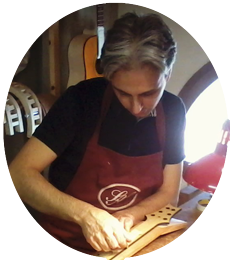
Visit the new website: www.buildyourownguitaronline.com
HOME > pickup placement along the guitar scale
PICKUP PLACEMENT ALONG THE GUITAR SCALE
The placement of pickups along the guitar scale is undoubtedly one of the most influential factors of the sound of the bass and the electric guitar.
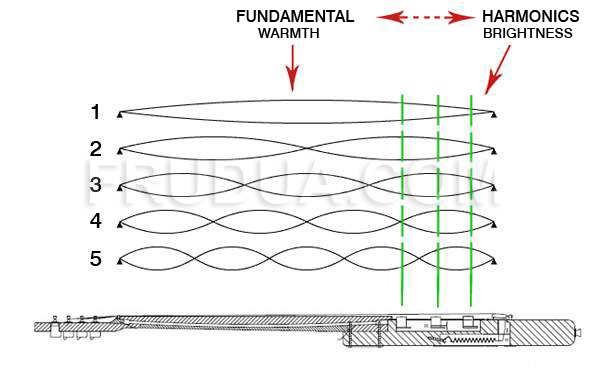
SOME POINTS OF HISTORY
By studying how great geniuses like Leo Fender and Les Paul designed their first instruments, we can understand more about the importance of pickup placement for our sound.
First of all, they both thought of moving the pickups as far apart as possible, in order to obtain the maximum sound variation and to make sure that the musician could pluck the strings as comfortably as possible.
Fender, however, added two interesting variations.
Having to use single coils, which make for notoriously bright pickups, Fender tilted the bridge pickup slightly towards the neck to give the low strings a little more roundness and warmth.
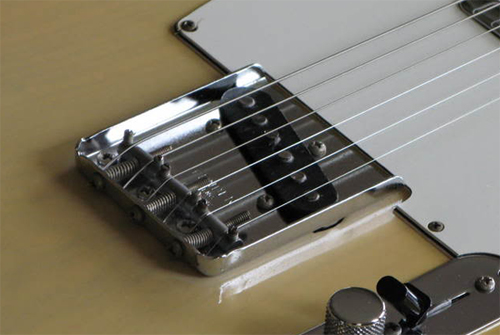
Here is a series of general rules:
- the further apart the pickups are, the greater the variety of sound we will get on the instrument.
- the closer the pickup to the centre of the empty string vibration, i.e. to the 12th fret, the warmer the sound will be, and the richer in volume and bass
- the closer the pickup to the bridge, the more brilliant the sound will be.
Moreover, on both the Stratocaster and the Telecaster, which at that time both had 21 frets, Fender went in search of a particular sound, deciding to position the pickup at the neck exactly on the third node of the fourth harmonic (where the 24th fret would theoretically be) and not as close as possible to the fretboard as one would expect.
In this position, the 4th harmonic does not play (see photo below).
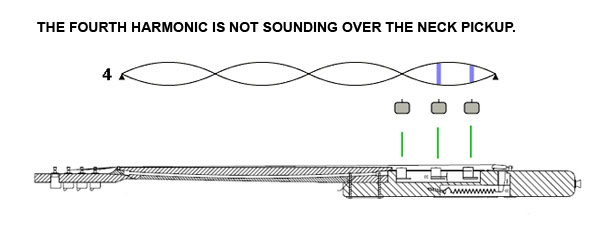
the 4th harmonic.
In the photo below we can also see how in that position the 5th harmonic vibrates in counterphase when both pickups play together as for example in the Telecaster when the selector is in the middle position (see blue and red dashes in the picture below).
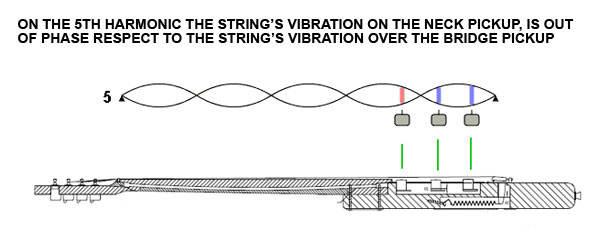
In other words, where Fender placed the neck pickup on his guitars, some harmonics of the note corresponding to the free-played notes do NOT sound or are in counterphase, and it is precisely this that contributes to create the typical "twang" sound of the tele that we all love.
Clearly Fender chose this exact point because he liked THAT sound.
This also teaches us something else: that Fender, when calculating the position of the pickup at the neck, considered the nodes and antinodes of the vibration by centring on the open string, giving more importance to the first two harmonics (fundamental and second) than to the subsequent partial ones. The fundamental is in fact the harmonic with the loudest volume.
CONCLUSION
In the final analysis, the rules to be observed when positioning the pickups are mainly the following:
1) assume that every calculation and reasoning must be effected on the vibration of the open string.
2) place them as far away as possible from each other in order to take advantage of the greatest possible variety of timbre
3) calibrate the position of the pickup at the bridge so that it is not too close or too far away to find the right compromise of brilliance and body
4) consider that the sounds we are used to hearing derive from choices made many years ago that today have become world timbre standards and therefore we should bear them in mind
5) that placing the pickup towards the bridge will have a greater sound impact than placing it towards the neck.
HELPFUL TIPS
This is a useful trick that has earned me the esteem of many professionals who use alternate picking: if you find yourself having to change a pickup on your guitar and you notice that the spacing of the poles does not match that of the strings, you should align the poles of the pickup to the high E, this is because the magnetic field that a mi cantino is able to influence is far less than that influenced by a thicker string.
If you didn't take this factor into account, the sound of the alternating plectrum from bottom to top would be different from the sound from top to bottom in the G-strings, si and mi.

